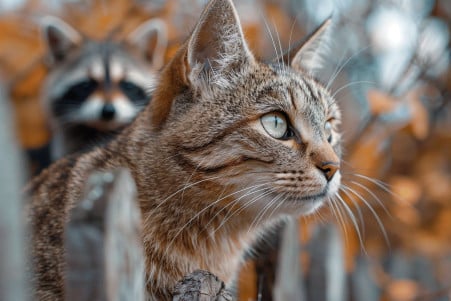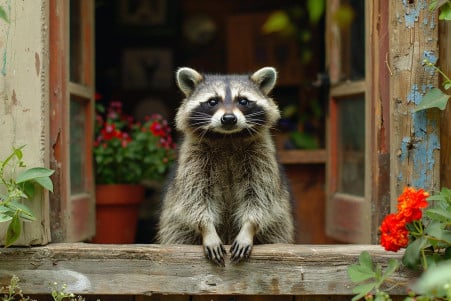Can Coatis Be Dangerous? What You Need to Know About the Threats of Coatis
14 April 2024 • Updated 13 April 2024

Although coatis are adorable, they are not the kind of animal you want to approach or keep as a pet. Coatis are wild animals and, as such, they can be unpredictable and aggressive. They also have sharp teeth and claws that they can use to protect themselves when they feel threatened, which can make them dangerous to humans.
To better understand the potential threats that these animals pose, we will review the scientific literature on coati behavior, physical attributes, and temperament. We will also summarize the results of studies that have investigated the factors that may lead to dangerous interactions between coatis and humans. This information will help you better understand the risks associated with interacting with these tropical mammals.
Can Coatis Be Dangerous?
Coati Behavior: Aggression, Territoriality, and Group Dynamics
Coatis are known for their aggressive behavior, which is often directed at one another and is primarily related to competition for food and water, especially during the breeding season when male-male aggression can become particularly intense. According to research cited by the International Environment Library Consortium, male-male aggression during the breeding season can lead to escalated aggression and even severe wounding or tooth loss. Females are known to form bands, which are cohesive social groups, and during the non-breeding season, they are known to be particularly aggressive toward males and to defend food resources, which they can do more effectively than males due to their smaller size.
In the wild, coatis typically escape from predators by running on the ground or climbing trees, as described in personal communications with B. Hirsch. However, in captivity or urban environments, coatis may freeze or climb to higher ground when they feel threatened. Their scavenging behavior and willingness to beg for food from humans, as described in research from the San Diego Zoo, can lead to aggression if they become habituated to humans as a source of food.
While these behaviors help coatis survive in their natural environment, they can pose problems when these intelligent, social animals come into contact with humans. It's important to know about their group dynamics, territoriality, and potential for defensive aggression to ensure that people and coatis can coexist in the areas where coati populations are found.
Coati Distribution and Habitat
Coatis are found throughout the Americas, from the southwestern United States to northern Argentina and Uruguay. National Geographic notes that there are four species of coati - the white-nosed, South American, eastern mountain, and western mountain coatis.
The white-nosed coati is located in the southwestern US, Mexico, Central America, and parts of Colombia, while the South American coati is located in South America, as its name suggests. Studies show that the mountain coati species are located in the Andes Mountains, with the eastern mountain coati listed as endangered due to factors such as deforestation.
Coatis are found in tropical and temperate woodland habitats, palm stands, and wetland areas, but they can also live in a variety of other habitats. That said, they are not often found in open grasslands or deserts, and they are more densely populated in the tropics than in the southwestern United States, according to researchers.
This broad distribution and ability to adapt to different habitats means that coatis are more likely to live near humans in some areas, which can lead to increased conflicts and risks that we'll discuss below.
Coatis as Exotic Pets: The Problems and the Reality
While some people do keep coatis as exotic pets, they have a number of special needs that make them a poor choice for the average pet owner. According to Explore Pet World, one of the biggest challenges of keeping a coati as a pet is meeting their dietary needs, which are much more complicated than feeding a cat or dog. Coatis are omnivores, and their diet should be made up of at least 30% protein, including eggs, nuts, and meat, along with fresh fruits and vegetables. This means that their owners will need to make frequent trips to the grocery store to keep them fed and spend time preparing their food.
In addition to their dietary needs, coatis are also very active and intelligent animals that need a lot of space and stimulation. As pointed out by J&D Exotics, coatis should be kept in an enclosure that is at least 6'x6'x6', and they need to be given toys and other forms of enrichment to keep them entertained and prevent them from becoming destructive. If they aren't properly socialized and stimulated when they are young, coatis can become aggressive and difficult to manage when they are adults.
Because of their special needs, as well as their behaviors and the fact that they can be unpredictable, coatis are not a good choice for the average pet owner. Even responsible exotic animal owners and experts agree that coatis are best left to experienced zoos and sanctuaries.
Conservation Status and Threats to Coati Populations
The IUCN currently lists the white-nosed and South American coati species as 'Least Concern', although some subspecies such as the dwarf coati are endangered, according to the IUCN Red List assessment. The eastern and western mountain coati species are classified as 'Near Threatened' and 'Endangered' respectively due to habitat loss, according to the IUCN fact sheet.
The most significant threats to coati populations are deforestation, the expansion of urban areas that encroach on their habitats, and hunting for food, fur, and pest control, according to a study of the South American coati. On the other hand, some coati species have shown a remarkable ability to adapt to urban environments by foraging on human food waste, as documented by scientists.
Efforts to conserve coatis and reduce human activities that threaten their habitats are essential to ensuring that these intriguing tropical mammals can coexist with people, especially since they are confronted by a variety of challenges in the many different environments they inhabit.
Living With Coatis: How to Stay Safe
If you live in an area where coatis are native, you need to take steps to avoid conflicts. Studies have shown that coatis can become a nuisance by raiding trash and begging for food, both of which can lead to aggressive interactions. To avoid attracting coatis, make sure that your yard and home are free of potential food sources like pet food, fruit that has fallen from trees, and unsecured trash.
It's also important to note that experts strongly discourage people from approaching, feeding, or trying to handle coatis, as doing so greatly increases the likelihood that you will be scratched, bitten, or otherwise hurt. According to a case report, coati attacks on humans can lead to severe lacerations from their sharp teeth and claws. If you encounter a coati, the best thing to do is to make loud noises or movements to scare it off, but don't back it into a corner or otherwise threaten it.
To further avoid conflicts, make sure that children and pets are supervised when they are outside in areas where coatis live, and consider putting up fencing to keep coatis out of your yard. In the end, the best way to live peacefully with these interesting but potentially dangerous tropical mammals is to support conservation and policies that protect coatis and their habitats from deforestation and urban development.
Conclusion: Understanding Coati Behavior
Although coatis are often seen as adorable and friendly, it is important to remember that they are wild animals that can be dangerous if provoked or habituated. Their natural behaviors, physical attributes such as sharp teeth and claws, and the potential for unpredictable aggression all mean that coatis need to be treated with a healthy level of respect.
Coatis also present a number of challenges as exotic pets because of their social and environmental needs, strength, and the fact that they are so wild. It is important to support coati conservation and reduce the impact of humans on their natural habitats in order to ensure that we can continue to share the planet with these interesting tropical creatures.


